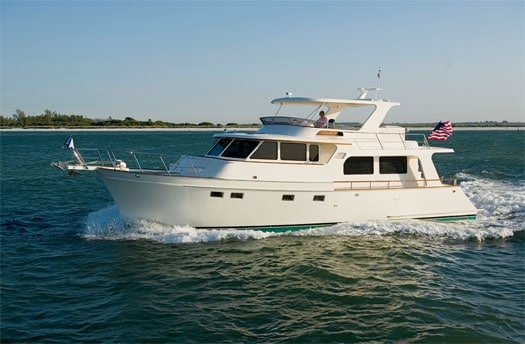
marlow57e1.jpg
As I write this, the Florida sky outside my office window is gray with low-flying scud and horizontal rain, the palm trees are bent far enough to be in a Winslow Homer hurricane, and the water is slate and rough. A big tropical depression is just to the east, while a high is just to the west. There is a huge pressure gradient between the two and, to use technical weather jargon, it’s blowing like hell.
Welcome to Marlow country.
I’ve always found it amusing that the sales brochures for yachts always show bright sunshine, smooth blue water, and tables set with tall wine glasses that might fall over if you looked at them sideways.
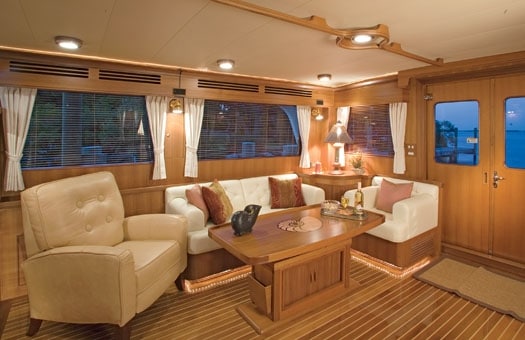
| | |
But it’s those don’t-wanna-be-out-here days, like today, that truly define a yacht. Funny how we don’t remember many of the flawless days, but we all have tales to spin about the days with big gray-bearded seas, surf pounding on a lee shore, and not many good choices.
Anyone can build a marina queen that is at home on protected waters. But, when you have your wife and your kids and maybe even the grandkids aboard and the weather turns grim, that’s when you want a Marlow underfoot.
If you step back from a Marlow, you realize it’s not just seaworthy design or extra solid construction or little details like sea rails on all the counters that make this a great yacht. It’s the culmination of a whole lot of little things that, when added up, have made Marlow a revered name among knowledgeable skippers.
The Marlow 57E Explorer shares the same hull as the 53-foot series, with a 14-degree deadrise and twin strut keels. These have so many advantages I don’t know why every builder doesn’t use them. The strut keels protect the running gear, props and rudders, from groundings and collisions with debris in the water. And the strut keels allow the Marlow to sit upright if you do find yourself aground.
Strut keels also greatly improve directional stability while helping to dampen roll. As a result, the Marlow 57 tracks with ease in large following seas and, if you find yourself struggling upwind in rough weather, the boat holds a course without sliding sideways.
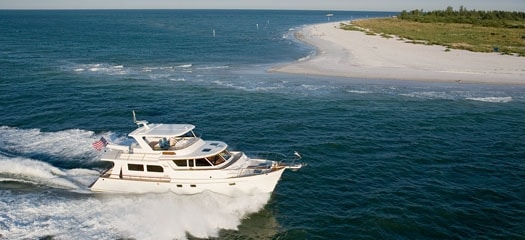
| | |
We had a perfect example the morning of our test. It had been blowing all night and, when we cast off from the Marlow pier on Snead Island in Florida, nothing happened. We all heard the engines shift into forward and the bow thruster rumbled, but we didn’t move an inch. The wind had literally blown the water out of the bay and we were aground.
But David Marlow wasn’t to be denied a boat test so, with judicious use of shifters and throttle, he literally drove the boat into deep water to freedom. Try that with exposed props and rudders, and you’ll be facing an astronomical yard bill. Even the long keel that many builders promote as grounding protection would have been useless in this situation.
So much for the Marlow hull, except to add that the “E” behind the name means a Euro-style reversed transom, although you can also opt for a more traditional style. The hull, and the rest of each Marlow, is built to both ABS and Lloyd’s classification, which means lots of surveys during construction and a painstaking pre-approval of the plans and construction schedule.
The goal for the 57 was to create a yacht that could be handled by a husband and wife team, with a layout suitable for cruising or living aboard. Marlow already has a hull for their 72-footers and most builders would have simply sawed it off like a Subway sandwich. David Marlow, however, didn’t want a high stubby yacht, and so he built mock-ups and tinkered with the layouts until he got it just right. The result is a yacht that is proper, or what old-timers call “yar.” It’s not too tall, the lines are sweet, and there is more than six feet of headroom in the engineroom.
The interior is better than yar. In a word, she’s gorgeous. She has a fullbeam master suite, a VIP cabin forward, and a portside stateroom that can be configured in a multitude of ways: guest cabin, office, or a combination. Of course, what makes the Marlow a great yacht is not any one thing but, rather, the perfectly orchestrated gathering of many good ideas, executed impeccably.
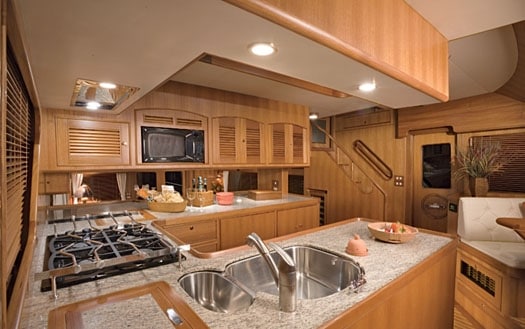
| | |
Take the electrical system, for example. The starting point, or at least the most visible point, is the beautifully labeled and illuminated electrical panel that puts everything at your fingertips. We have a growing demand for electricity aboard our yachts to power everything from navigational electronics to theater systems to microwaves and, when something stops working, it can be anything from irritating to frightening.
So the ability to quickly and easily track down the problem is crucial. Anyone who has tried to chase down a short on board a yacht knows what a frustrating experience that is. But not aboard a Marlow. There are little hidden panels, held in place by Velcro rather than screws so they’re easy to remove. Pop one open and you’ll find neatly loomed and color-coded wiring. Hand rails are important on any yacht that actually goes to sea but they can also get in the way. Marlow very neatly recesses them into the bulkheads. One curves down the stairwell to the lower deck, for example, and it’s right where you want it. But you’ll never snag a jacket sleeve on it. Same with the steps up from the pilothouse to the bridge, except that there are rails on both sides for security here.
Little details make the difference between a real yacht, like a Marlow, and a play yacht. Deep sea rails around every counter keep things from sliding around, and dishes are neatly racked in lockers to prevent rattles or breakage.
Check out the recessed overhead treatment above the galley because you’d never guess it’s actually a big access hatch to reach all the electronics in the bridge console.
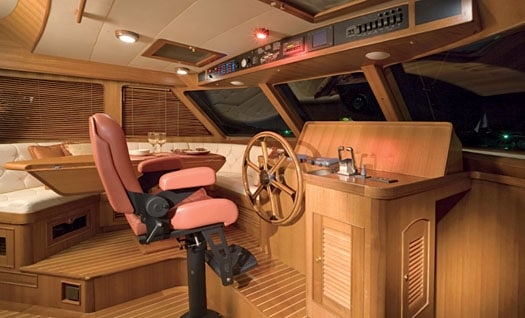
| | |
Take a look in the bilge of the Marlow 57 and be prepared for a shock: it’s better finished than the exterior of many yachts. Even the access holes have laminated teak trim. Raw fiberglass is absent: everything is high-gloss finished.
Pull open any drawer, and you’ll find dove-tailed joints for long life, and stainless steel rollers that won’t stick or corrode. Check out the workbench in the engineroom and you’ll find gorgeous teak drawers on ball-bearing slides.
Even the lowly fuel tank warranted thoughtful design. The single tank has a central sump and sloping sides, which means that the fuel pick-up will never be starved by rolling, which means more usable fuel in the tank. In addition, any sediments drift down to the pick-up, where they are filtered out in the fuel system. Believe me, it’s a lot easier to get rid of gunk from a spin-off filter than it is to climb into a fuel tank and clean it out by hand.
The engineroom has a huge seachest, which reduces the number of through-hull fittings and is a seamanlike installation but, in some cruising areas, it can be a target for growth like zebra barnacles. On the Marlow, a so-called Zeta Rod is installed in the seachest, which electronically prevents growth that might clog the water inlets. Very clever.
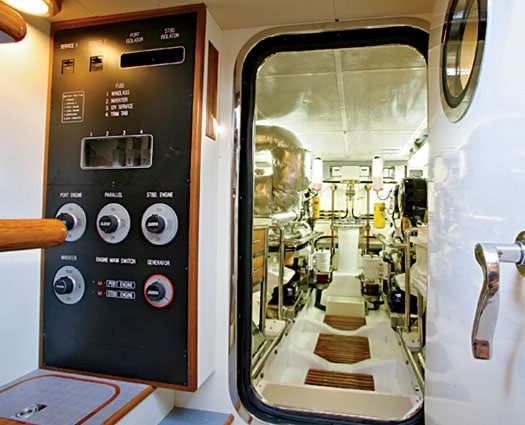
| | |
Needless to say, the Marlow is a delight offshore: solid and seaworthy and predictable. With the standard Caterpillar C9s of 575hp each, the top speed on the 57E is around 21 knots, with a comfortable cruise at 2100rpm of 17-18 knots.
If you’ve owned a yacht before, give yourself plenty of time to tour the Marlow 57E Explorer, because you’ll keep seeing things that will make you smile. Ways of doing things better, ideas to simplify maintenance, or just the sheer indulgence of high quality.
It’s all there in a Marlow, and the 57E is a perfect example.









